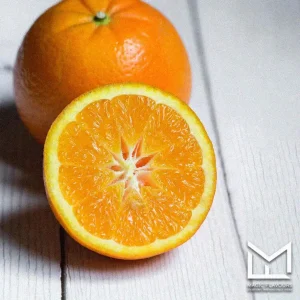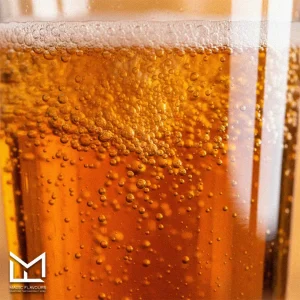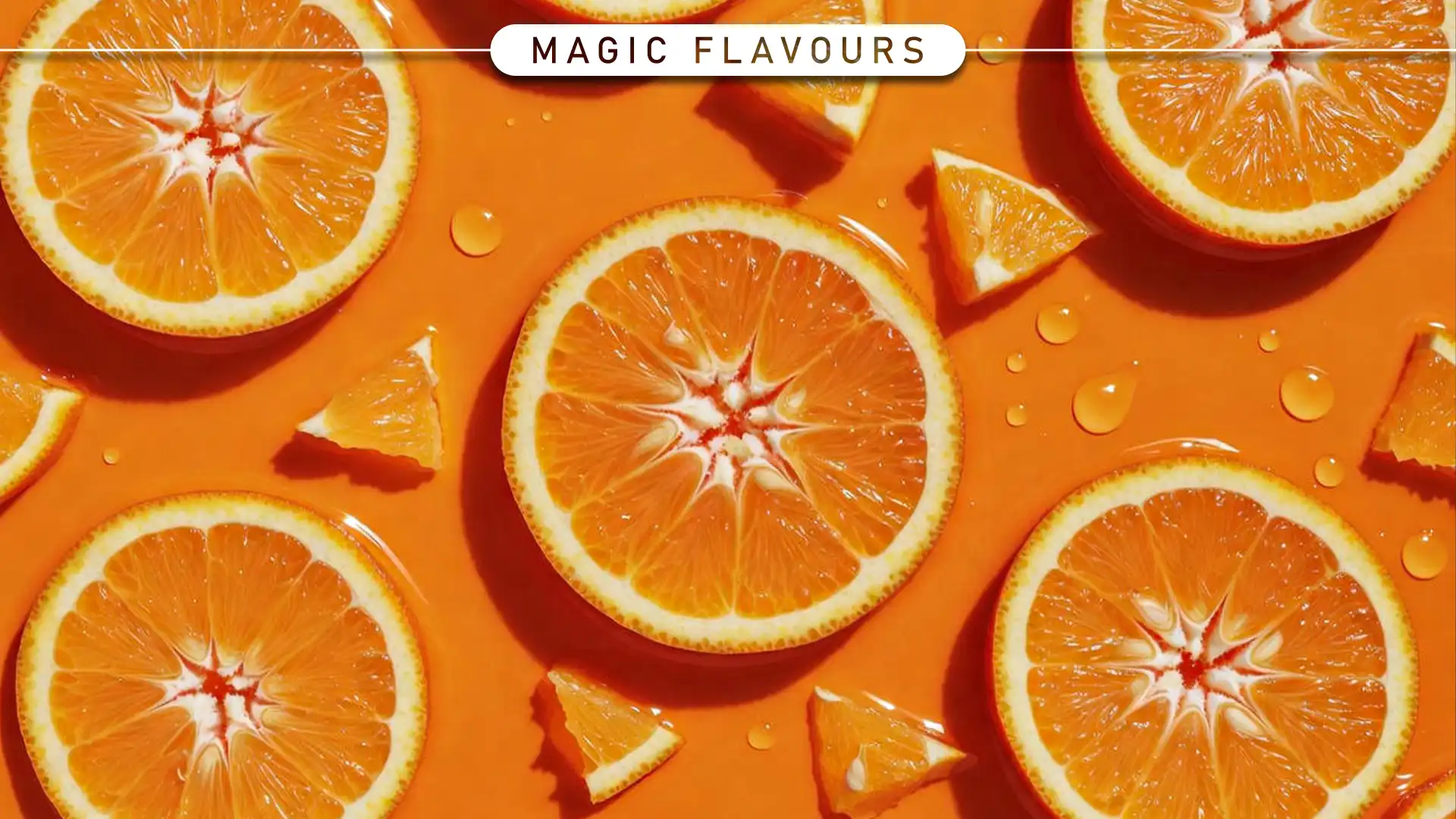1: The Sensory Power of Orange
From Peel to Pulse: What Makes Natural Orange Flavor Irresistible
Natural Orange flavor starts with the peel, where essential oils hold the brightest notes. Because of this, extraction matters deeply. Even cold-pressed oils vary depending on fruit origin and ripeness. Therefore, sourcing impacts the final sensory experience. While some prefer sweet profiles, others lean toward zesty or bitter. That’s why orange flavor offers flexibility across categories.
As you explore orange flavor, you’ll notice its balance between freshness and warmth. This duality makes it ideal for layering. For example, sparkling drinks use it to lift acidity. Meanwhile, confectionery blends it with vanilla to soften the edge. So, orange flavor adapts to both bold and subtle formats. Because of this, it remains a top choice for developers.
Orange flavor also connects emotionally. Since citrus evokes summer and energy, it builds instant appeal. Whether in wellness shots or hookah molasses, it signals brightness. That’s why brands use it to anchor sensory identity.
Aromatics and Volatiles: The Chemistry Behind Natural Orange Flavor
Orange flavor owes its complexity to volatile compounds like limonene and aldehydes. These molecules shape aroma and taste together. Because they’re highly reactive, formulation must protect them. Even slight oxidation can dull the citrus lift. Therefore, encapsulation or emulsification often improves stability.
When you compare orange flavor types, FTNF (From The Named Fruit) stands out. It preserves the full aromatic spectrum. While synthetic versions mimic sweetness, they lack depth. That’s why natural orange flavor performs better in premium applications. Moreover, it aligns with clean-label goals.
Volatiles also influence perception over time. As products age, orange flavor may shift toward waxy or muted notes. Because of this, shelf-life testing is essential. Developers often adjust pH or packaging to preserve brightness. So, chemistry isn’t just technical—it’s strategic.
Sweet, Sour, and Slightly Bitter: The Orange Flavor Trifecta
Orange flavor balances three key notes: sweet, sour, and bitter. This trifecta creates its signature complexity. Because sweetness dominates, it pairs well with tart fruits. Sourness adds lift, especially in beverages. Meanwhile, bitterness grounds the profile, adding adult appeal.
When you adjust ratios, orange flavor shifts dramatically. For example, sour-forward blends suit energy drinks. On the other hand, sweet-heavy versions work in candy. That’s why segmentation matters. Developers must match flavor balance to consumer expectations.
Bitterness often comes from peel extracts. Although some avoid it, others embrace it for sophistication. Because of this, orange flavor can target both mass and niche markets. Whether you want playful or refined, the trifecta gives you control.
Color Psychology: Natural Orange Flavor as a Signal of Freshness and Energy
Orange flavor doesn’t just taste bright—it looks bright too. Because color influences perception, it enhances sensory impact. In fact, orange hues signal freshness, vitality, and warmth. That’s why brands often match flavor with visual cues.
When consumers see orange, they expect citrus. So, color sets the stage before tasting begins. This expectation boosts flavor acceptance. Moreover, it reinforces emotional connection. Orange flavor becomes more than a taste—it becomes a feeling.
Color also affects category positioning. For example, orange flavor in wellness drinks suggests immunity and energy. Meanwhile, in hookah molasses, it evokes tropical escape. Because of this, color strategy supports flavor storytelling. So, orange flavor works on multiple sensory levels.
2: What ‘Natural’ Really Means
Defining Natural Orange Flavor: Clean Label, Real Impact

Natural orange flavor carries weight in today’s clean-label market. Because consumers seek transparency, definitions matter more than ever. While “natural” sounds simple, it varies by region and source. That’s why brands must clarify what they mean.
In most cases, natural orange flavor comes from real fruit. Whether it’s extracted from peel or juice, origin matters. Because of this, FTNF (From the Named Fruit) claims build trust. They also support premium positioning across categories.
However, natural doesn’t always mean fresh-squeezed. Some orange flavor uses natural precursors or fermentation. While still compliant, these methods may confuse buyers. That’s why education is key. Clear labeling helps bridge science and perception.
Sources of Natural Orange Flavor: Essential Oils, Extracts, and FTNF
Natural orange flavor can come from several sources. Because each method affects taste, developers must choose wisely. Essential oils offer brightness, but they may lack depth. On the other hand, juice extracts bring body and sweetness.
FTNF remains the gold standard. Since it’s derived directly from orange juice, it preserves full flavor. That’s why it’s preferred in high-end applications. Whether in beverages or confectionery, FTNF signals authenticity.
Some suppliers also use enzyme-treated orange compounds. While technically natural, these may alter sensory notes. Because of this, testing is essential. Developers should compare sources before scaling up. Orange flavor deserves precision.
Regulatory Landscape: Natural Orange Flavor in EU vs US
Regulations shape how orange flavor is labeled. In the US, “natural” includes flavors from natural sources—even if modified. Because of this, enzymatic or fermented citrus may qualify. However, the EU takes a stricter view.
In Europe, orange flavor must come directly from the named fruit. That’s why FTNF is often required. If the flavor includes other citrus, it may lose its “natural orange” claim. So, compliance depends on both source and process.
These differences affect global launches. When scaling across markets, brands must adjust labels. Because of this, regulatory strategy becomes part of flavor development. Orange flavor must meet both sensory and legal standards.
Consumer Perception: Natural vs Artificial Orange Flavor
Consumers respond emotionally to the word “natural.” Because of this, orange flavor must feel real. Even if artificial versions taste similar, they lack trust. That’s why natural orange flavor drives purchase intent.
In blind tests, natural orange flavor often wins. Its aroma feels fuller, and its taste lingers longer. Because of this, it performs better in wellness and premium categories. Artificial versions may work in cost-driven formats, but they rarely inspire loyalty.
Perception also depends on storytelling. When brands explain origin—like peel extraction or FTNF—they build connection. So, orange flavor becomes more than a taste. It becomes a story consumers want to believe.
3: Technical Formulation Insights
Formulating with Natural Orange Flavor: Challenges and Opportunities

Natural orange flavor brings both excitement and complexity to formulation. Because its volatile, stability becomes a top concern. Even mild heat can degrade citrus notes. That’s why developers must test across pH, temperature, and packaging formats.
Orange flavor also interacts with other ingredients. For example, proteins may bind aroma compounds. Because of this, dairy and plant-based systems need special attention. Emulsifiers or encapsulation can help preserve brightness. So, technical choices shape sensory success.
Despite challenges, orange flavor offers strong payoff. It delivers freshness, familiarity, and emotional lift. Because of this, it’s worth the effort. Whether in beverages or confectionery, the right approach unlocks full potential.
Solubility and Stability in Acidic Systems
Orange flavor often appears in acidic products like sodas and gummies. Because of this, solubility is critical. Oil-based flavors may separate or cloud. That’s why water-soluble formats are preferred in clear beverages.
Stability also depends on pH. At low pH, some orange flavor compounds degrade faster. Because of this, buffering agents or antioxidants may be needed. Developers must balance taste with shelf-life goals.
Encapsulation can improve both solubility and stability. It protects orange flavor from oxidation and heat. So, even in harsh systems, citrus notes stay fresh. That’s why encapsulated formats are gaining traction.
Heat and Light Sensitivity: Protecting Orange Flavor
Orange flavor is sensitive to heat and light. Because of this, processing conditions must be controlled. High temperatures can flatten citrus notes. That’s why cold-fill or post-blend methods are often used.
Light exposure also affects aroma. UV rays may trigger oxidation or off-flavors. Because of this, packaging matters. Amber bottles or foil wraps help protect orange flavor integrity.
Developers should also consider antioxidants. These compounds slow degradation and extend shelf life. So, orange flavor stays vibrant longer. That’s why stability testing is essential before launch.
Pairing and Layering: Natural Orange Flavor with Vanilla, Spice, and Smoke
Orange flavor pairs beautifully with other profiles. Because of its brightness, it lifts heavier notes like vanilla or spice. For example, orange and cinnamon evoke warmth and nostalgia. That’s why this combo works in seasonal launches.
Vanilla softens orange flavor’s acidity. It adds creaminess and depth. Because of this, it’s ideal for confectionery and dairy. Meanwhile, smoke adds intrigue. Orange flavor with smoky notes feels bold and modern.
Layering also helps target different audiences. Sweet blends suit youth markets. Spiced or smoked versions appeal to adults. So, orange flavor becomes a flexible tool. That’s why pairing strategy matters in flavor design.
4: Application Spotlight
Natural Orange Flavor in Beverages: From Sparkling Waters to Energy Drinks
Orange flavor shines in beverages because it’s familiar, refreshing, and versatile. Whether in sparkling water or juice, it delivers brightness. That’s why it’s often used as a base or top note. Even in complex blends, orange flavor adds clarity.
In energy drinks, orange flavor balances sour and sweet. Because of this, it supports caffeine and functional ingredients. It also masks bitterness from botanicals or vitamins. So, orange flavor improves both taste and performance.
Carbonation lifts orange flavor further. Bubbles enhance aroma release and mouthfeel. That’s why citrus is popular in sodas and mixers. Whether still or sparkling, orange flavor brings energy and appeal.
Natural Orange Flavor in Confectionery: Gummies, Chews, and Hard Candy
Orange flavor fits perfectly in confectionery. Because it’s bright and sweet, it appeals to all age groups. Gummies use it to anchor fruit blends. Meanwhile, chews and hard candy showcase its clean finish.
Texture affects flavor release. In soft formats, orange flavor unfolds slowly. That’s why it pairs well with creamy or layered profiles. Hard candy, on the other hand, delivers a fast citrus hit. So, format shapes experience.
Color also plays a role. Orange flavor often matches orange hues, reinforcing sensory expectations. Because of this, it builds trust and recognition. Whether playful or premium, orange flavor performs reliably.
Orange Flavor in Wellness: Functional Foods and Supplements

Orange flavor supports wellness products by adding freshness and familiarity. Because it’s linked to vitamin C, it signals health. That’s why it’s used in immunity shots and supplements.
In powders and tablets, orange flavor masks bitterness. It also improves mouthfeel in effervescent formats. Because of this, it boosts compliance and repeat use. Consumers trust citrus to taste clean and effective.
Functional foods also benefit. Orange flavor pairs well with adaptogens, collagen, and fiber. So, it enhances both taste and positioning. That’s why wellness brands rely on it for emotional and functional impact.
Orange Flavor in Hookah Molasses: Citrus as a Brightening Agent
Orange flavor adds lift to hookah molasses. Because it’s bright and clean, it balances heavier profiles. Tobacco, spice, and cream all benefit from citrus contrast.
In blends, orange flavor acts as a top note. It opens the experience before deeper flavors emerge. That’s why it’s used in tropical and dessert formats. Even smoky profiles feel fresher with orange.
Moisture and heat affect flavor release. Orange flavor must be stable under heat and humidity. Because of this, formulation matters. When done right, it creates a smooth, vibrant session.
5: Market Trends and Consumer Drivers
Citrus in Global Flavor Forecasts: Why Orange Flavor Leads
Orange flavor continues to lead global citrus trends. Because it’s familiar and versatile, it appears in nearly every category. From beverages to wellness, orange flavor remains a top performer. That’s why forecasters rank it among the most resilient profiles.
Emerging markets also favor orange flavor. In Asia and the Middle East, citrus signals freshness and energy. Because of this, orange flavor supports both traditional and modern formats. Whether in molasses or sparkling drinks, it adapts easily.
Flavor houses invest heavily in citrus innovation. Orange flavor often anchors new blends with uncommon fruits or botanicals. So, it drives both novelty and comfort. That’s why it stays relevant across generations.
Natural Claims and Purchase Intent: Orange Flavor Builds Trust
Natural orange flavor boosts consumer confidence. Because shoppers read labels, “natural” claims influence buying decisions. That’s why clean-label citrus performs better in wellness and premium segments.
Purchase intent rises when orange flavor feels authentic. FTNF and peel extracts build trust through origin stories. Because of this, brands use sensory language to reinforce natural positioning. Even simple phrases like “from real oranges” make a difference.
Transparency also matters. When brands explain how orange flavor is sourced, they build loyalty. So, natural claims aren’t just technical—they’re emotional. That’s why storytelling supports conversion and repeats purchase.
Gen Z and Millennial Preferences: Bright, Familiar, and Trustworthy

Gen Z and Millennials love orange flavor for its brightness and clarity. Because it feels familiar, it lowers trial barriers. That’s why it appears in new formats like gummies, shots, and sparkling teas.
These consumers also value function. Orange flavor often signals immunity or energy. Because of this, it supports wellness goals without feeling medicinal. So, it blends health with pleasure.
Trust is key for younger audiences. Natural orange flavor aligns with their values—clean, transparent, and sensory-rich. That’s why it performs well in social campaigns and influencer-led launches. Orange flavor feels real, and that matters.
6: Strategic Positioning Tips
Storytelling Through Origin and Extraction: How to Elevate Orange Flavor
Orange flavor becomes more powerful when you tell its story. Because origin matters, highlight where the fruit was grown. Whether it’s Mediterranean or tropical, each region adds nuance. That’s why sourcing supports emotional connection.
Extraction also shapes perception. Cold-pressed oils feel fresh, while FTNF signals authenticity. Because of this, process becomes part of the brand. When you explain how orange flavor is made, you build trust. So, transparency drives value.
Even technical details can feel engaging. Mentioning peel vs juice extraction adds depth. Because of this, orange flavor becomes more than a label. It becomes a sensory promise.
Sensory Language That Sells: Describing Orange Flavor with Impact
Words shape experience. Because consumers can’t taste before buying, language must do the work. That’s why sensory storytelling matters. Orange flavor should sound bright, juicy, and uplifting.
Avoid vague terms like “citrusy.” Instead, describe the burst, the lift, the clean finish. Because of this, your copy feels alive. Whether in brochures or LinkedIn posts, sensory words drive engagement.
Use comparisons to guide expectation. Orange flavor can be “like fresh peel at sunrise” or “a sweet spark in every sip.” So, language becomes your flavor tool. That’s why copywriting supports conversion.
Blending Orange Flavor with Emerging Trends: Staying Ahead of the Curve
Orange flavor stays relevant by blending with new trends. Because it’s flexible, it pairs well with botanicals, spices, and florals. That’s why developers use it in immunity blends and mood boosters.
Emerging formats also matter. Orange flavor works in gels, sprays, and dissolvables. Because of this, it supports innovation across delivery systems. So, it’s not just about taste—it’s about experience.
Trend alignment builds credibility. When orange flavor joins adaptogens or nootropics, it feels modern. That’s why it appears in wellness and lifestyle launches. Orange flavor evolves, and your positioning should too.
7: Conclusion
Orange Flavor Is More Than a Taste—It’s a Feeling
Orange flavor delivers more than sensory impact—it creates emotional connection. Because it’s bright and familiar, it evokes warmth and energy. That’s why it works across cultures and categories. Whether in wellness drinks or hookah molasses, orange flavor feels uplifting.
It also adapts to changing consumer needs. From clean-label to functional formats, orange flavor stays relevant. Because of this, it supports both innovation and tradition. So, it’s not just a flavor—it’s a strategic asset.
When used with intention, orange flavor builds brand identity. It signals freshness, trust, and joy. That’s why it deserves thoughtful formulation and storytelling.
Final Takeaways for R&D and Marketing Teams

Orange flavor offers technical flexibility and emotional power. Because of this, it bridges science and storytelling. R&D teams should explore stability, solubility, and pairing strategies. Meanwhile, marketers must highlight origin, extraction, and sensory appeal.
Cross-functional collaboration matters. When flavor scientists and brand teams align, orange flavor performs better. That’s why shared language and goals are key. So, build flavor stories that resonate with both developers and buyers.
Orange flavor isn’t just an ingredient—it’s a message. Because of this, every detail counts. From sourcing to copywriting, it shapes perception and drives results.
Call to Action: Sampling, Collaboration, and Innovation
Now is the time to explore orange flavor more deeply. Request samples, run stability tests, and build layered blends. Because hands-on experience drives insight, sampling is essential.
Collaborate across teams to unlock full potential. Whether you’re launching a new beverage or reformulating a classic, orange flavor can lead the way. That’s why early alignment matters.
Innovation starts with curiosity. So, ask questions, test formats, and challenge assumptions. Orange flavor is ready to evolve—and your next product could be the proof.
